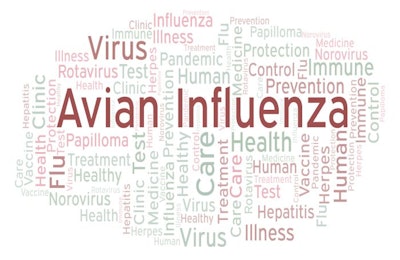
In the past week, the veterinary authority of Albania has registered the country’s first ever cases of highly pathogenic avian influenza (HPAI) linked to the H5N8 virus variant in poultry.
Over the period May 21 to June 4, outbreaks occurred in three backyard farms in different districts of the country, according to the official report to the World Organisation for Animal Health (OIE). Directly impacted were 590 poultry, 158 of which died, and the rest have been destroyed.
At all the affected premises, poultry were kept free-range, and wild birds are thought to be the source of the virus. First cases were in a flock of 120 four-month-old turkeys in Kukes county in the north-east of Albania. Other outbreaks were in the center of the country — in mixed flocks of 400 birds in Tirana — the county that includes the capital city of the same name — and 70 more in in neighboring Durres.
One of the Balkan countries, the Republic of Albania is located in southeastern Europe.
Neighboring Albania is the Republic of Kosovo, which has also registered its first HPAI outbreak of 2021. In the northern district of Mitrovica, the same virus variant (H5N8) was detected for the first time last month. According to the European Reference Lab for avian influenza, IZSVe, this affected a poultry farm with 300 birds.
Latest news on avian flu in Dutch poultry
The most recent avian flu outbreak in the Netherlands — reported last week — has been linked to the H5N8 HPAI virus variant. Affected was a free-range flock of 56 birds in Vleuten in the province of Utrecht, according to Wageningen University & Research. This source puts the number of HPAI outbreaks at the country’s poultry farms since last October at 12. While the H5N1 HPAI virus was detected at one location, all other outbreaks have been linked to the H5N8 variant. Directly impacted have been around 509,000 commercial poultry.
From the Netherlands came an announcement to the OIE that the earlier situation with the H5N2 LPAI virus variant in poultry has been “resolved.” This virus was detected at one farm in South Holland in December. After all 38,677 birds were depopulated and destroyed, cleaning and disinfection of the premises was completed by January 22. There were no poultry farms within one kilometer of the outbreak. All restrictions in the area have been lifted, and no further cases have been detected.
Evolving avian situation elsewhere in European poultry flocks
Based on official reports to the OIE, the HPAI situation generally across Europe continues to ease.
Apart from the first detection of the H5N8 HPAI virus in Albania, the only other country to register with the OIE new cases in poultry over the past week has been the Czech Republic. However, these amounted to additional mortality and culls at a previously affected farm in the northern region of Hradec Kralove. In early April, the H5N8 variant had been detected at the premises, where there were around 9,408 ducks. All surviving birds have been culled to reduce the risk of further spread of the infection, and the outbreak was described as ended by the end of May.
Since the first HPAI outbreak in Czech poultry was confirmed in January of this year, 37 outbreaks have been recorded. Direct losses of poultry through death and destruction are approaching 280,000 birds
Earlier this month, the same virus variant was detected in two small poultry flocks in Lithuania. As well as nine dead wild swans that tested positive for this virus, HPAI has affected almost 1,200 poultry in the country since the start of this year.
Latest reports to the OIE from the respective animal health agencies indicate there have been no new cases of HPAI in poultry in France (H5N8 or the low-pathogenic avian influenza — LPAI — H5N3 variants), or the United Kingdom (highly pathogenic H5N1 and H5N8, as well as LPAI H5N2 and H5N3 virus subtypes).
First detections of HPAI virus in wild birds in the Netherlands, Serbia
At the start of March, a swan found dead in the north of the Republic of Serbia tested positive for the H5N8 HPAI virus. According to the report recently submitted to the OIE, the bird was found dead in the West Backa District.
Also from the Netherlands came a retrospective notification of the first detection of the H5N3 HPAI virus in a wild bird in the country. In early January, a buzzard found dead in the north-eastern province of Groningen tested positive for this variant.
Dutch veterinary authorities have also registered with the OIE new cases of HPAI in wild birds over the past week. Cases found between January and May of this year tested positive for the H5N1, H5N4, or H5N8 HPAI virus variants.
Over a similar period, the H5, H5N5 or H5N8 virus types have been detected in five birds of prey in Sweden, according to the latest official reports to the OIE.
In Finland, 10 wild birds found dead in the Southern and Eastern regions of the country in May tested positive for the H5N1 HPAI virus.
Italy, Russia declare H5N5 HPAI in wild birds 'resolved'
Over the past week, the animal health agencies of Italy and Russia have declared to the OIE that the HPAI situation has been resolved in their respective countries. This applies in both cases to the H5N5 virus subtype.
For Italy, just one wild bird had tested positive for this variant in the Veneto region in November of last year. Russia also reported a single outbreak linked this virus type. At the end of March, it was detected in a group of around 100 pelicans that died near the Caspian Sea coast of Astrakhan oblast.
View our continuing coverage of the global avian influenza situation.

















